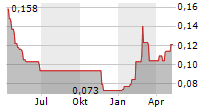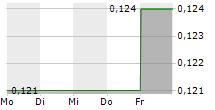
MELBOURNE, Australia, Dec. 4, 2024 /PRNewswire/ -- Cynata Therapeutics Limited (ASX: "CYP", "Cynata", or the "Company"), a clinical-stage biotechnology company specialising in cell therapeutics, has successfully completed its Phase 1 clinical trial of CYP-006TK in diabetic foot ulcers (DFU).
Key Highlights
- The trial met its primary objective, with CYP-006TK found to be safe and well-tolerated - no participants withdrew from the trial due to adverse events, and no suspected serious adverse reactions were reported.
- Importantly, the trial also generated positive efficacy data, indicating improved wound healing for CYP-006TK compared to the standard of care control group.
- The mean[1] change from baseline in wound surface area was:
- After 12 weeks, a decrease (improvement) of 181 mm2 in the CYP-006TK group, and an increase (deterioration) of 355 mm2 in the standard of care control group.
- After 24 weeks (end of study), a decrease (improvement) of 261 mm2 in the CYP-006TK group, and an increase (deterioration) of 62 mm2 in the standard of care control group.
- The mean change from baseline in wound surface area expressed as a percentage was:
- After 12 weeks, a decrease (improvement) of 64.6% in the CYP-006TK group compared to a decrease of 22.0% in the standard of care control group.
- After 24 weeks, a decrease (improvement) of 83.6% in the CYP-006TK group compared to a decrease of 47.8% in the standard of care control group.[2]
- The study also indicates that larger wounds in particular healed to a greater extent in the CYP-006TK group compared to the standard of care control group.
Dr Jolanta Airey MD, Cynata's Chief Medical Officer said:
"Diabetic foot ulcers represent a substantial unmet medical need; they are a very prevalent and challenging complication of diabetes worldwide due to high morbidity, high risks of lower extremity amputation and associated mortality. Patients have a high rate of recurrent hospitalisations with consequent cost to the healthcare system. There is a desperate need for more effective interventions to improve wound healing and thus reduce the risk of severe infection and amputation. The results from this clinical trial of Cynata's topical MSC product are very promising. If subsequent trials confirm similar effects, then we might be on the path to a therapy that promotes successful wound healing in this challenging condition. We look forward to working with Cynata to continue development of this innovative product."
Dr Kilian Kelly , Cynata's Chief Executive Officer and Managing Director, said:
"We are very pleased and encouraged by these results. First and foremost, the trial achieved its primary objective of safety. Furthermore, whilst the trial was not powered to show statistically significant efficacy, we believe there is a clear signal indicating improved wound healing compared to standard of care treatments in this trial. We will now turn our attention to the next steps for this exciting program, including our strategy for further clinical development, engagement with regulatory agencies (including the FDA) and engagement with potential commercial partners. Finally, today's results further exemplify the commercial attractiveness of the broader Cymerus platform, with the Company now having two distinct product candidates that have generated positive clinical data - CYP006 -TK in DFU, and CYP-001 in graft versus host disease, which also previously demonstrated very encouraging safety and efficacy data.[3],[4] The Company eagerly awaits further results from three more clinical trials over the next ~18 months which could also further add to the commercial attractiveness of the Cymerus platform."
About the Clinical Trial
CYP-006TK is Cynata's Cymerus iPSC[5]-derived MSC[6] topical wound dressing product candidate, which comprises MSCs seeded onto a novel silicone dressing.
Due to reduced blood flow, patients with diabetes are at risk of developing non-healing wounds on the feet/lower limbs, which are also known as DFU. In addition to causing severe pain and discomfort, DFU pose a significant risk of infection, and if treatment is unsuccessful, amputation may be necessary - an outcome that occurs in ~20% of patients who develop DFU.[7] An estimated 38 million Americans have diabetes,[8] up to 34% of whom will develop DFU.[9] The annual costs to US public and private payers to treat DFU are estimated to be US$9 -13 billion per year.[10]
In this Phase 1 trial, which took place at a number of clinical centres around Australia, a total of 30 patients with DFU were randomised to receive either:
(i) CYP 006TK treatment for four weeks, followed by standard of care treatment for the rest of the study; or
(ii) standard of care treatment throughout the study.
Follow-up visits in this trial continued until 24 weeks after the initiation of study treatment. At each follow-up visit, three-dimensional images of the study ulcer were taken using specialised camera equipment. Images were then analysed by a technician independent of the clinical centre and blind to treatment allocation. This facilitated calculation of the wound surface area, and consequently the change in size of the wound over time.
Results of the Clinical Trial
The primary objective of the trial was to assess the safety and tolerability of CYP-006TK. There were no suspected serious adverse reactions[11] reported, and no participants withdrew from the trial due to adverse events. The only adverse events considered to be at least possibly related to CYP-006TK treatment were non-serious, mild to moderate local administration site reactions, which occurred in seven participants.
Change in wound surface area from baseline was assessed using the mixed-effects model for repeated measures, which is a standard statistical approach used to assess this type of outcome measure.
The mean change from baseline in wound surface area expressed in terms of mm2 was:
- After 12 weeks, a decrease (improvement) of 181 mm2 in the CYP-006TK group, and an increase (deterioration) of 355 mm2 in the standard of care control group.
- After 24 weeks (end of study), a decrease (improvement) of 261 mm2 in the CYP-006TK group, and an increase (deterioration) of 62 mm2 in the standard of care control group.
The mean change from baseline in wound surface area expressed as a percentage was:
- After 12 weeks, a decrease (improvement) of 64.6% in the CYP-006TK group compared to a decrease of 22.0% in the standard of care control group.
- After 24 weeks, a decrease (improvement) of 83.6% in the CYP-006TK group compared to a decrease of 47.8% in the standard of care control group.[2]
Analysis of Larger Wounds (wounds measuring>200 mm2)
The Company also conducted an analysis that segmented participants by wound size at baseline. This analysis indicates that CYP-006TK had a particularly pronounced benefit in larger wounds.
A total of eleven participants had wounds measuring <200 mm2 at baseline (six in the CYP-006TK group; five in the control group). If wounds <200 mm2 are excluded, and the remaining larger wounds (>200 mm2) are analysed separately,[12] there are even greater differences in outcomes between groups:
- The mean change from baseline in wound surface area for larger wounds was:
- After 12 weeks, a decrease (improvement) of 262 mm2 in the CYP-006TK group, and an increase (deterioration) of 540 mm2 in the standard of care control group.
- After 24 weeks (end of study), a decrease (improvement) of 354 mm2 in the CYP-006TK group, and an increase of 135 mm2 in the standard of care control group.
- The mean change from baseline in wound surface area for larger wounds, expressed as a percentage was:
- After 12 weeks, a decrease (improvement) of 68.4% in the CYP-006TK group compared to an increase of 3.9% in the standard of care control group.
- After 24 weeks, a decrease (improvement) of 84.2% in the CYP-006TK group compared to a decrease of 32.2% in the standard of care control group. [2]
This indicates that the potential wound healing benefit of CYP-006TK is even greater in larger wounds. This is especially encouraging as patients with larger wounds are more likely to experience an amputation.[13]
Conclusion
The trial met its primary objective of demonstrating safety and tolerability of CYP-006TK in participants with DFU. Importantly, the trial also generated positive efficacy data, indicating improved wound healing in the CYP-006TK group compared to the standard of care control group. It is also encouraging that this study indicates that larger wounds healed to a greater extent in the CYP-006TK group compared to the standard of care control group.
Continued Trading Halt
The Company will remain in trading halt pending an announcement of a potential capital raising, which is expected no later than opening of trading on Friday, 6 December 2024. The Company is not aware of any reason why the halt should not continue, nor any other information necessary to inform the market about the trading halt.
About Cynata Therapeutics (ASX: CYP)
Cynata Therapeutics Limited (ASX: CYP) is an Australian clinical-stage stem cell and regenerative medicine company focused on the development of therapies based on Cymerus, a proprietary therapeutic stem cell platform technology. Cymerus overcomes the challenges of other production methods by using induced pluripotent stem cells (iPSCs) and a precursor cell known as mesenchymoangioblast (MCA) to achieve economic manufacture of cell therapy products, including mesenchymal stem cells (MSCs), at commercial scale without the limitation of multiple donors.
Cynata has demonstrated positive safety and efficacy data for its Cymerus product candidates CYP-001 and CYP-006TK, in Phase 1 clinical trials in steroid-resistant acute graft versus host disease (GvHD), and diabetic foot ulcers (DFU), respectively. Further clinical trials are now ongoing: a Phase 2 trial of CYP-001 in GvHD under a cleared US FDA IND; a Phase 1/2 trial of CYP-001 in patients undergoing kidney transplant; and a Phase 3 trial of CYP-004 in osteoarthritis. In addition, Cynata has demonstrated utility of its Cymerus technology in preclinical models of numerous other diseases, including critical limb ischaemia, idiopathic pulmonary fibrosis, asthma, heart attack, sepsis, acute respiratory distress syndrome (ARDS) and cytokine release syndrome.
Cynata Therapeutics encourages all current investors to go paperless by registering their details with the designated registry service provider, Automic Group.
[1] Mean calculated using the mixed-effects model for repeated measures; differences were not statistically significant, as expected given that the study was not powered to show efficacy. [2] For clarity, the Company confirms that the change from baseline in the control group at both 12 and 24 weeks was an increase when calculated as mean change in mm2, but a decrease when calculated as a percentage. While this may seem like a discrepancy, it is correct - it is a consequence of wound size at baseline varying between patients. For example, if there were two wounds, one measuring 100 mm2, and the second measuring 1,000 mm2 at baseline, and: [3] Bloor AJC, et al. Nat Med. 2020;26:1720-1725. [4] Kelly K, et al. Nat Med. 2024;30(6):1556-1558. [5] iPSC = induced pluripotent stem cell. [6] MSC = mesenchymal stem (or stromal) cell. [7] McDermott et al. Diabetes Care. 46:209-221 (2023). [8] American Diabetes Association: https://diabetes.org/about-diabetes/statistics/about-diabetes [9] McDermott et al. Diabetes Care. 46:209-221 (2023). [10] Raghav et al. Ther Adv Endocrinol Metab. 9(1) 29-31 (2018). [11] A suspected adverse reaction is when a causal relationship between the investigational product and an adverse event is at least a reasonable possibility. [12] Post-hoc analysis. [13] Pickwell K, et al. Diabetes Care. 2015;38(5):852-7. |
SOURCE Cynata Therapeutics




